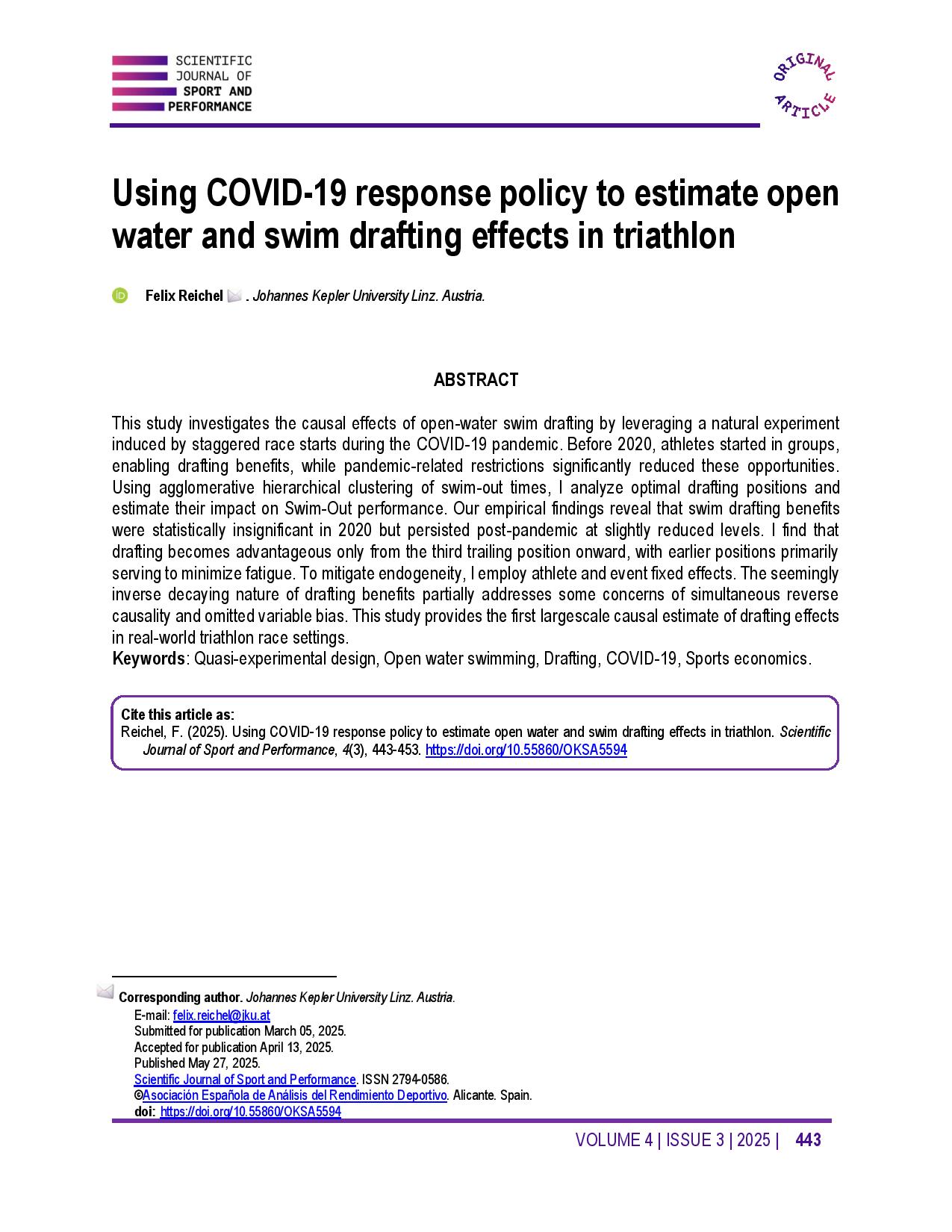Using COVID-19 response policy to estimate open water and swim drafting effects in triathlon
Main Article Content
Abstract
This study investigates the causal effects of open-water swim drafting by leveraging a natural experiment induced by staggered race starts during the COVID-19 pandemic. Before 2020, athletes started in groups, enabling drafting benefits, while pandemic-related restrictions significantly reduced these opportunities. Using agglomerative hierarchical clustering of swim-out times, I analyze optimal drafting positions and estimate their impact on Swim-Out performance. Our empirical findings reveal that swim drafting benefits were statistically insignificant in 2020 but persisted post-pandemic at slightly reduced levels. I find that drafting becomes advantageous only from the third trailing position onward, with earlier positions primarily serving to minimize fatigue. To mitigate endogeneity, I employ athlete and event fixed effects. The seemingly inverse decaying nature of drafting benefits partially addresses some concerns of simultaneous reverse causality and omitted variable bias. This study provides the first largescale causal estimate of drafting effects in real-world triathlon race settings.
Article Details

This work is licensed under a Creative Commons Attribution-NonCommercial-ShareAlike 4.0 International License.
References
Bolon, B., Pretot, C., Clanet, C., Larrarte, F., and Carmigniani, R. (2020). Drafting of two passive swim- mer scale models for open-water races. Soft Matter, 16(31), 7270-7273.
Chatard, J.-C., Lavoie, J.-M., Bourgoin, B., and Lacour, J.-R. (1990). The contribution of passive drag as a determinant of swimming performance. International Journal of Sports Medicine, 11(4), 367-372. https://doi.org/10.1055/s-2007-1024820 DOI: https://doi.org/10.1055/s-2007-1024820
Chatard, J.-C., and Wilson, B. (2003). Drafting distance in swimming. Medicine & Science in Sports & Exer- cise, 35(7), 1176-1180. https://doi.org/10.1249/01.MSS.0000074564.06106.1F DOI: https://doi.org/10.1249/01.MSS.0000074564.06106.1F
Delextrat, A., Tricot, V., Bernard, T., Vercruyssen, F., and Hausswirth, C. (2003). Drafting during swimming improves efficiency during subsequent cycling. Medicine & Science in Sports & Exercise, 35(9), 1612- 1619. https://doi.org/10.1249/01.MSS.0000084422.49491.2C DOI: https://doi.org/10.1249/01.MSS.0000084422.49491.2C
Leitner, S. (2021). Massenstart oder Einzelstart? Triathlon Szene Österreich, January 8. Retrieved from [Accessed 2025, May 06]: https://www.trinews.at/massenstart-oder-einzelstart/
Millet, G., Chatard, J.-C., and Chollet, D. (1999). Effects of kicking, performance, and drag during draft swimming in elite triathletes. In Les Cahiers de l'INSEP (No. 24, pp. 209-216). Proceedings of the 2nd INSEP International Triathlon Congress. https://doi.org/10.3406/insep.1999.2115 DOI: https://doi.org/10.3406/insep.1999.2115
Ohmichi, H., Takamoto, M., and Miyashita, M. (1983). Measurement of the waves caused by swimmers. In Hollander, A. P., Huijing, P. A., and de Groot, G. (Eds.), Biomechanics and Medicine in Swimming V (pp. 103-107). Champaign, IL: Human Kinetics.
Olbrecht, J. (2011). Triathlon: Swimming for winning. Journal of Human Sport and Exercise, 6(2), 233-246. https://doi.org/10.4100/jhse.2011.62.04 DOI: https://doi.org/10.4100/jhse.2011.62.04
Österreichischer Triathlonverband (ÖTRV). (2020). ALOHA TRI Steyregg feiert Premiere. Triathlon Austria. Retrieved from [Accessed 2025, May 06]: https://www.triathlon-austria.at/de/newsshow-alle--aloha-tri-steyregg-feiert-premiere?return=240
Toussaint, H. M., Bruinink, R., Coster, R., and others. (1989). Effect of triathlon wet suit on drag during swimming. Medicine & Science in Sports & Exercise, 21(3), 325-328. https://doi.org/10.1249/00005768-198906000-00017 DOI: https://doi.org/10.1249/00005768-198906000-00017




